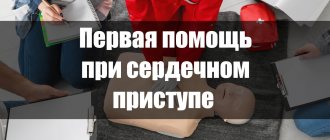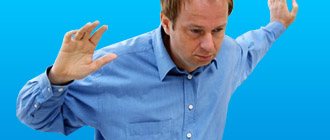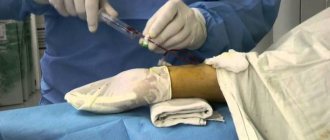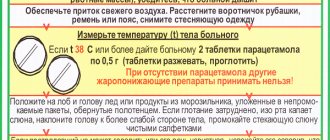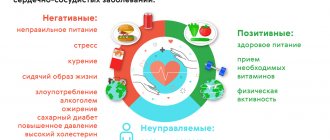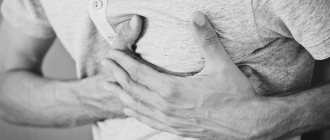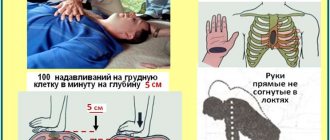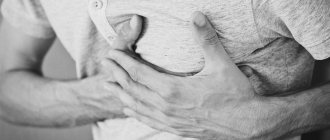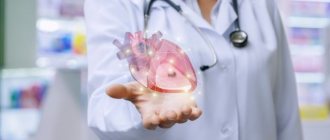Efficiency. Professionalism. Mercy
Heart pain due to angina pectoris
Coronary heart disease is a chronic disease that manifests itself as periodic attacks of pain in the heart or behind the sternum.
Attacks of angina pectoris occur during physical exertion, emotional experiences, as well as with increased blood pressure, diabetes mellitus and other situations.
Signs of angina: paroxysmal, squeezing or pressing pain behind the sternum, lasting up to 20 minutes. The pain radiates to the left shoulder, forearm, hand, and shoulder blade. There may be hard-to-explain sensations in the chest, a feeling of lack of air, and causeless weakness. Possible increased frequency of attacks and increased pain.
Help with pain syndrome:
- If pain occurs during exercise, you must immediately stop working and, if possible, sit comfortably, without tension, with your legs down.
- Provide access to fresh air (open a window, unbutton clothing that makes breathing difficult).
- Take Nitromint aerosol one dose (0.4 mg) or Nitroglycerin 1 tablet (0.0005 g) under the tongue, if necessary, can be repeated after 3-5 minutes, up to 3 doses in total.
- Take Acetylsalicylic acid (aspirin) – chew 1 tablet (0.5 g) or 4 tablets of Clopidogrel (300 mg).
- If the pain does not go away after taking these medications, call an ambulance.
Remember! Nitroglycerin lowers blood pressure, as indicated by the appearance of severe weakness, sweating, nausea, pale skin, and headache. Therefore, “to be safe,” you cannot take 2-3 tablets at the same time.
Heart pain during acute myocardial infarction
If the symptoms (complaints) described above last for more than 20 minutes, cold, sticky sweat appears, a feeling of fear, pallor, fingertips and lips turn blue, and possible single vomiting occurs, then you can think about myocardial infarction.
Only a medical specialist can recognize an acute heart attack at an early stage.
Help with pain syndrome:
- Call an ambulance.
- Go to bed.
- Take Nitromint aerosol one dose (0.4 mg) or Nitroglycerin 1 tablet (0.0005 g) under the tongue, if necessary, can be repeated after 3-5 minutes, up to 3 doses in total.
- Take Acetylsalicylic acid (aspirin) – chew 1 tablet (0.5 g) or 4 tablets of Clopidogrel (300 mg)
If the heart attack passed quickly and you did not call an ambulance, then you need to contact your local physician on the same day (call to your home).
Follow these tips and they will help you avoid complications and save your life.
FIRST AID FOR EMERGENCY CARDIOVASCULAR DISEASES
When the coronary vessels delivering blood to the heart are narrowed (atherosclerosis, coronary heart disease, etc.), the tissues of the heart muscle do not receive enough oxygen necessary for its normal functioning, and lactic and other acids accumulate, which causes pain . This pain is angina. Myocardial infarction is the death of heart muscle tissue as a result of blockage or spasm of the blood vessel supplying the heart. When extensive death of some cardiac tissue occurs, the heart is unable to contract effectively, resulting in a life-threatening condition. SIGNS OF ANGINA AND MYOCARDIAL INFARCTION 1. Pressing, squeezing, aching pain, a feeling of tightness or heaviness in the chest. The pain is retrosternal and can radiate to the shoulder, arm, neck, lower jaw or back. 2. Difficulty breathing. 3.Fast, slow or irregular pulse. 4. Pale or bluish skin. 5. Increased sweating. 6.Nausea or vomiting, often reminiscent of indigestion. If the pain is severe and chest discomfort does not go away within 10 minutes after taking nitroglycerin, immediately call an ambulance and begin first aid for a heart attack. FIRST AID FOR ANGINA AND MYOCARDIAL INFARCTION 1. The patient should stop all physical activity. 2. Help the patient take a comfortable position (often a sitting position). 3.Loosen your tie and waist belt. 4. Help the patient take nitroglycerin. 5.After 5 minutes, if the pain has not gone away, the patient should take a second nitroglycerin tablet. 6. Try to calm and reassure the patient. This helps the patient overcome anxiety and alleviates the pain somewhat.
CARDIAC STILL Cardiac arrest is a critical condition because the brain and other vital organs remain viable for only a few minutes without oxygenated blood! Signs of cardiac arrest are lack of consciousness, lack of breathing, and lack of pulse in the patient. If there are signs of cardiac arrest, it is necessary to carry out pulmonary-cardiac resuscitation - this is artificial ventilation of the lungs with simultaneous rhythmic pressure of medium force on the lower third of the sternum, alternating 1 breath through the patient’s mouth with simultaneous pinching of his nose and 4 pressures on the sternum. Without resuscitation procedures, brain death occurs within 5-6 minutes. HYPERTENSIVE CRISIS
This is an emergency condition in which blood pressure rises rapidly and leads to significant and irreversible organ damage within a few hours.
Signs of a crisis: 1. Headache. 2.Dizziness. 3.Redness of the face. 4. Increased heart rate, rhythm disturbance. 5.Difficulty breathing.
First aid for a crisis: 1.Sit the patient down. 2. Remind about the need to take a quick-acting medicine if the patient has forgotten to take it. 3.Call an ambulance. 4.Do not allow taking aspirin.
STROKE
This is an acute disorder of cerebral circulation, leading to the death of brain cells as a result of hemorrhage from a ruptured blood vessel (hemorrhagic stroke) or lack of blood supply as a result of the formation of a blood clot in a brain vessel (ischemic stroke).
Signs of a stroke: 1. Sudden weakness. 2.Numbness of the face, arms, legs, usually on one side. 3.Difficulty speaking or understanding it. 4. Sudden severe headache. 5.Difficulty walking due to dizziness, loss of balance or coordination. 6. Sudden visual disturbances. 7. Uneven pupil dilation. 8. Unconscious state.
First aid for a stroke: 1. Call an ambulance. 2. Place the patient in the recovery position with the paralyzed side up to allow fluid to drain from the mouth. If saliva and vomit are present, remove them from the patient's mouth.
Ways to Prevent a Heart Attack
If a patient is diagnosed with coronary artery disease or experiences a sharp increase in blood pressure, it is recommended to always have nitroglycerin and aspirin with you. The risk of developing SP is much higher:
- in the presence of great physical and psychological stress;
- with excessive cholesterol levels in the blood;
- alcohol abuse;
- smoking;
- the presence of a genetic predisposition.
It is important that relatives or others have basic CPR (cardiopulmonary resuscitation) skills, measuring blood pressure, pulse, and heart rate.
If you are predisposed to a heart attack, it is recommended to regularly visit a cardiologist and keep a “Diary” in which you note your pulse and blood pressure daily. The “Blood Pressure Control Diary” should be shown to the doctor in order to select effective drug therapy.
Best materials of the month
- Coronaviruses: SARS-CoV-2 (COVID-19)
- Antibiotics for the prevention and treatment of COVID-19: how effective are they?
- The most common "office" diseases
- Does vodka kill coronavirus?
- How to stay alive on our roads?
Signs of a heart attack
Content:
- Signs of a heart attack
- Algorithm of action in the event of a heart attack
- Ways to Prevent a Heart Attack
- Important information
One of the symptoms of a heart attack, chest pain, often begins in the middle of the chest and may move to the neck, jaw, ears, arms and wrists. It can be localized between the shoulder blades, in the back and in the stomach area.
If a patient has chest pain, the pain can be either sharp or dull. It is described as "heaviness, burning, tightness, narrowing, squeezing" or a feeling of intense pressure. The attack may be similar to indigestion or heartburn.
Precursors of a heart attack: an increased feeling of anxiety, unexplained fatigue, discomfort, excitement, the severity of physical activity that was previously performed easily, pain is observed not only in the chest, but also in the back, arms, etc., the intensity of heart pain increases, accompanied by squeezing and intense burning, attacks of heart pain become longer, and sharp pain occurs in the chest area. Women, older people and people with any stage of diabetes are at risk. At the slightest suspicion of a heart attack, it is recommended to call an ambulance as quickly as possible.
Among the types of heart attack, it is worth noting the painful form (sudden intense, pressing, burning, squeezing paroxysmal pain for up to five minutes in the left half of the chest or behind the sternum, sometimes the pain radiates to the upper abdomen, the left half of the neck, under the left shoulder blade, left arm) and non-painful form (sharp feeling of suffocation, single vomiting, dizziness, weakness, interruptions in heart function, shortness of breath).
Only a doctor can accurately establish a diagnosis; therefore, at the first sign of an attack, it is imperative to call an ambulance or take the patient to the nearest medical facility.
First aid for heart painHeart pain due to angina pectoris
Coronary heart disease is a chronic disease that manifests itself as periodic attacks of pain in the heart or behind the sternum.
Attacks of angina pectoris occur during physical exertion, emotional experiences, as well as with increased blood pressure, diabetes mellitus and other situations.
Signs of angina: paroxysmal, squeezing or pressing pain behind the sternum, lasting up to 20 minutes. The pain radiates to the left shoulder, forearm, hand, and shoulder blade. There may be hard-to-explain sensations in the chest, a feeling of lack of air, and causeless weakness. Possible increased frequency of attacks and increased pain.
Help with pain syndrome:
· If pain occurs during exercise, stop it immediately and, if possible, sit comfortably, without tension, with your legs down.
· Provide access to fresh air (open a window, unbutton clothing that makes breathing difficult).
· Take Nitromint aerosol one dose (0.4 mg) or Nitroglycerin 1 tablet (0.0005 g) under the tongue, if necessary, can be repeated after 3-5 minutes up to 3 doses.
· Take Acetylsalicylic acid (aspirin) – chew 1 tablet (0.5 g) and/or 4 tablets of Clopidogrel (300 mg).
· If the pain does not go away after taking these medications, call an ambulance
Remember! Nitroglycerin lowers blood pressure, as indicated by the appearance of severe weakness, sweating, nausea, pale skin, and headache. Therefore, “to be safe,” you cannot take 2-3 tablets at the same time.
Heart pain during acute myocardial infarction
If the symptoms (complaints) described above last for more than 20 minutes, cold, sticky sweat appears, a feeling of fear, pallor, fingertips and lips turn blue, and possible single vomiting occurs, then you can think about myocardial infarction.
Only a medical specialist can recognize an acute heart attack at an early stage.
Help with pain syndrome:
· Call an ambulance.
· Go to bed.
· Take Nitromint aerosol one dose (0.4 mg) or Nitroglycerin 1 tablet (0.0005 g) under the tongue, if necessary, can be repeated after 3-5 minutes up to 3 doses.
· Take Acetylsalicylic acid (aspirin) – chew 1 tablet (0.5 g) and/or 4 tablets of Clopidogrel (300 mg)
If the heart attack passed quickly and you did not call an ambulance, then you need to contact your local physician on the same day (call to your home).
Follow these tips and they will help you avoid complications and save your life.
